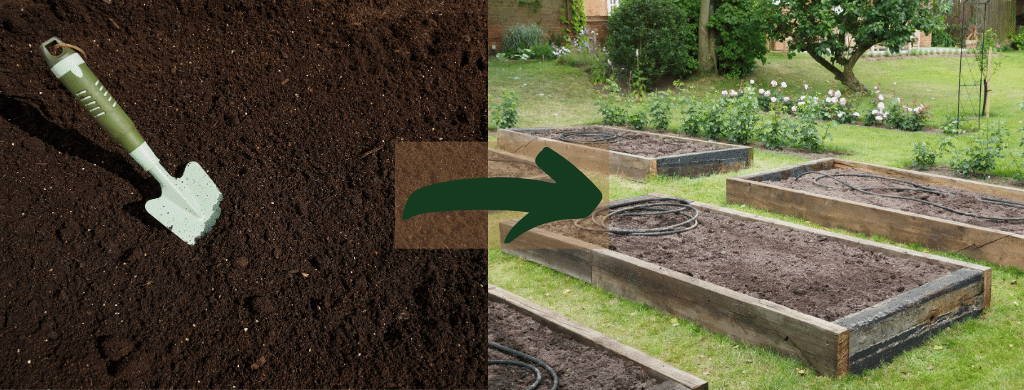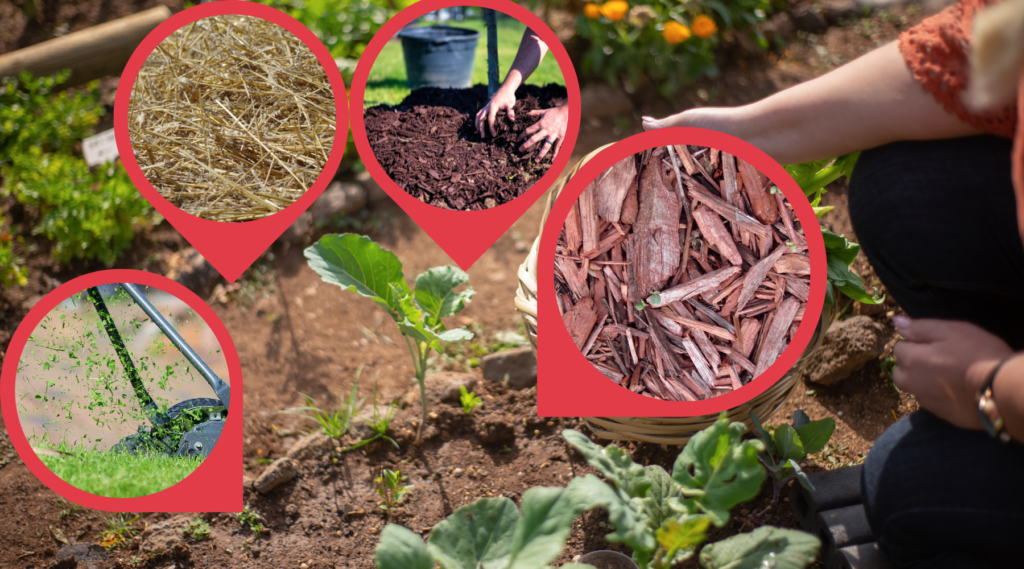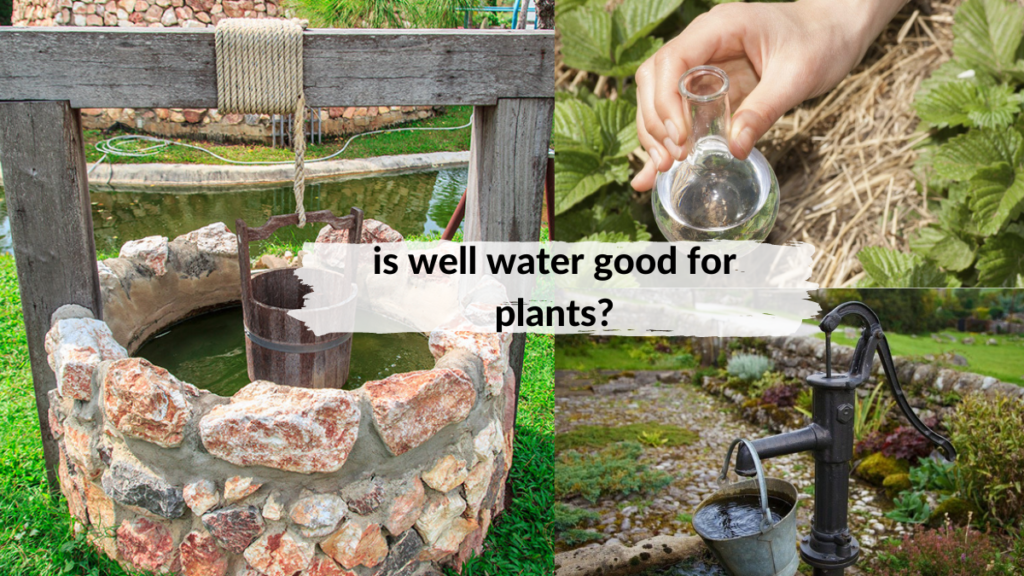Healthy and good soil is an essential component for the success of a garden. Through developing a permanent garden layout where walking paths and raised beds in place year after year, you will be able to keep soil compaction at a minimum and enjoy having an easy to maintain and healthy garden you will be proud of. Soil needs water and air to function and it will be robbed of both if compaction from foot traffic occurs.
Permanent raised beds can be of any shape or size provided that you can reach the center as you stand in the paths. It is optional to use edging although most gardeners love using borders like stones, boards, or logs.
Raised beds are perfect for areas with poor drainage or places with clay soil. Gardeners who wish to extend the growing season to late fall and early spring can benefit from raised beds and the warming effect they produce.
To get the best out of your raised beds, one of the first things you should know is how to make the best garden soil for raised beds.

recipe on how to make soil for raised garden beds
Nutritious and healthy vegetables thrive better in a properly balanced loose organic soil that is rich in essential minerals and nutrients.
This type of soil doesn’t only support the healthy growth of plants as this can also help in warding off common plant conditions and diseases.
how do you prepare all-purpose and high-volume organic soil?
For example, you like to fill a raised garden bed measuring 4-foot by 8-foot with 1 foot of soil. In this kind of situation, the following soil recipe can be considered:
- Organic compost of 3 cubic feet
- Bags of peat moss of 11 cubic feet each
- Organic chicken manure of 3 cubic feet
- Worm castings of 4 cubic feet
- Azomite of 6 pounds
- Vermiculite of 4 cubic feet
- Organic kelp meal of 2 pounds
- Calcium-rich oyster shell flour of 6 pounds

common ingredients or amendments for raised bed soil
One of the benefits of raised garden beds is that you can tailor your soil to the specific components that can work best for the plants you wish to grow.
If you will use garden soil for your raised bed, there might be a need for you to amend this using other materials.
The purpose of this is to balance the soil for moisture retention and proper retention and ensure that it contains enough rich organic material that can support healthy plant growth.
Assuming you got a basic idea of the sand and clay content, you need to perform a soil test and know the basic level of nutrients.
Garden centers and hardware stores offer simple test kits for the purpose. You can follow the instructions on the label to have a good idea of the soil ph and the available potassium, soluble potash, phosphorus, or nitrogen levels.
Here are the common soil amendments that can help in adjusting the test results:
- Sand – This can be purchased in bags or bulk. For soil with high clay content, you have to mix a considerable amount of sand to enhance drainage and make the expansion of plant roots easier. This admittedly requires some hard work.
- Greensand – It is a type of sand with a slightly higher level of soluble potash or potassium. You can add it with sand for soil conditioning and adjusting a slightly acidic ph.
- Vermiculite – These are spongy and soft tiny bits that resemble pebbles made from superheating mica. Adding this to the soil improves aeration and retains moisture.
- Azomite – This is a hydrated sodium calcium aluminosilicate that contains minerals as well as other types of trace elements. This can also serve as a helpful substitute to perlite if the soil test comes back to show low mineral content.
- Perlite – This one is harder compared to vermiculite. This is also made through superheating volcanic glass. Even though this can help with aeration, this is not as good compared to vermiculite as far as moisture retention is concerned.
- Peat moss – Peat moss is prized because of its moisture retention and arability. This is preferred by young plants because of its ability to allow the growth of tender new roots. If you have plans to grow some plants that love moist soil in a certain location, it is better to use peat moss instead of clay. Take note, however, that peat moss contains very little available nutrients.
- Green compost – This is a type of compost that is not completely matured just yet and has the tendency to contain high nitrogen levels. Green compost should never be used in the shallow and uppermost layers of raised beds. You should add a thick green compost layer at the bottom layers that can help in feeding mature plants with deep roots during the peak of the summer season. It helps give them time to mature.
- Mature compost – This can help boost the soil’s nutrient profile. Mature compost can be of great help in increasing nitrogen levels. This can also help improve the ability of the soil to retain moisture with no need to add clay.
- Manure – Similar to green compost, it is something that you should never add to the soil’s uppermost layers. If you ever have some chicken manure handy, you might want to mix this with ground oak leaves then use the mixture to layer the bottom level of the raised bed. After some time, the potent manure mixture is going to mature into compost where plants can get nutrients for the next coming years.
- Clover and alfalfa – Once dried then crumbled to the mid and upper layers of the soil, clover and alfalfa can boost the nitrogen levels. It is very useful for seedlings and plants with shallow roots.

different types of soil for raised beds
If you are wondering what type of soil you should get for your raised bed, take a look at the most common options available in a garden center:
- Potting mix is a type of lightweight soil containing the mixture of several ingredients such as coconut husks, sphagnum moss, vermiculite, bark, and compost. It might not even have any soil content at all. This is also sterilized to prevent the introduction of fungus or other organisms to the raised bed.
- The potting mix is specifically made for various growing purposes such as vegetable gardening and cultivating specialty flowers such as orchids. It also works well as a container garden or raised bed soil because this is lightweight and allows aeration and good drainage.
- Raised garden bed mix is the same as the potting mix. In case you want to prepare your own raised bed soil mix, you can use a 50% potting mix and 50% garden soil for good aeration and drainage. Garden centers also sell bagged soils made for raised beds that can make it an ideal choice for the soil in a raised bed.
- Garden soil is a type of dense soil composed of topsoil mixed with some other materials for particular planting purposes like growing shrubs and trees or vegetable gardening. Since this is heavy soil, it might not be the best choice for raised beds as it can result in compaction.
- In case you want to use this as the soil for your raised beds, regular soil amendment using compost is important to limit compaction. This soil works in elevated gardens provided that you layer coconut coir or peat moss first and use compost to amend the soil.
- Top soil should never be used in raised garden beds as this acts as a soil conditioner used for filling in gaps in the in-ground gardens. Topsoil gets pulled from the earth’s top root or so and can be composed of pretty much anything based on where this was taken from. Topsoil is quite dense and doesn’t contain proper nutrients.
Now that you have an idea of the different types of soil, you can go to the nearest garden center with a better idea of the type of soil to get for your raised bed.

can you use garden soil in your raised beds?
Always remember that soil differs from location to location. If you’ve got some extra budget, you can use the expensive mixture of high-quality potting soil and garden soil from the garden center.
Unfortunately, for most gardeners, the cost is the main concern. Also, soil from your garden or lawn would have become compacted after some time.
If you already got an established garden yet you are planning to add some raised garden beds, the soil there can be used as a base but you should amend this with things such as perlite, vermiculite, sand, and other types of additives.
The objective here is to ensure that your base is decent and nutrient-rich while maintaining proper drainage and aeration.
You might have seen the ads about screen black dirt that is often sold by the cubic yard. It means that the price per volume will be better compared to what you can see in bags available in garden centers and hardware stores.
It works as a decent base although you will likely see it compact after some time.
There is also a chance that the individual or company that sells the black dirt can also give you some other soil amendments or refer you to someone who can.

is it necessary to replace raised bed garden soil?
As time passes by, the plants that grow in a raised garden bed will deplete all the available nutrients little by little. Even the most properly aerated and well-balanced soil will also start to compact at the same time. If your mound system doesn’t have a frame, all you need to do is fill up all the rows the augment these again every spring.
This can still be done even in the more popular framed types of raised beds. The only difference is that it will require more labour since you have to lean over then shovel the excess soil out.
If you have a brand new raised bed, it would be enough to just hand till its top layers for the first and second years.
Once you reached the third year, you might want to dig deeper to help in loosening the soil then amending it again.
A soil test kit can also be used for measuring the pH and nutrient profile of the lower and middle layers of the soil. It helps you dial in the soil amendments you wish to add. If you are lucky, adding one or two yards of mature compost, every year can boost the raised bed soil so, you can have healthy plants throughout the summer season.




